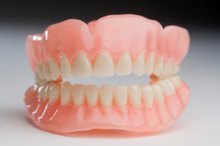Harmful Effects of Eating Sugarless Gum Everyday
Chewing gum used to be frowned upon by dentists. Not only was it full of sugar, but it also remained in the mouth longer than candies that you could swallow, making it a greater cause of tooth decay. However, in the 1950s, manufacturers introduced sugarless gum, which used an artificial sweetener that did not corrode the teeth. This form of gum could be chewed regularly without causing cavities. However this did not diminish other concerns about its daily use.
TMJ Disorders
The temporomandibular joint (TMJ) is the place where the jaw attaches to the skull. If the muscles that hold this joint in its correct alignment become fatigued, the joint can move out of place, causing a TMJ disorder. This often results in jaw pain, headache and reduced movement or locking of the joint. Moderate gum chewing does not usually cause TMJ disorders; however, habitual chewing can cause muscle fatigue that may put you at risk. Particularly hard or vigorous chewing is especially stressful on the joint and surrounding muscles.
- The temporomandibular joint (TMJ) is the place where the jaw attaches to the skull.
- If the muscles that hold this joint in its correct alignment become fatigued, the joint can move out of place, causing a TMJ disorder.
Tooth Deformities
Tooth Pain and Sweets
Learn More
Excessive gum chewing can wear the enamel off your teeth and change your bite. In particular, the upper molars tend to spread, while the lower ones diminish. The upper front teeth may also drift forward while the lower ones drift backward, creating an overbite. These changes may require orthodontic care to correct. Furthermore, as the enamel erodes, your teeth may become more sensitive to hot, cold and acidic foods.
- Excessive gum chewing can wear the enamel off your teeth and change your bite.
- The upper front teeth may also drift forward while the lower ones drift backward, creating an overbite.
Headaches
When any muscle repeats the same motion for a long period of time, it can become fatigued. This applies to the facial muscles that are responsible for moving the jaw during chewing. As a further complication, most people primarily chew their gum on one side of their mouth, fatiguing the muscles unequally. This can cause headaches, especially when the chewing is rapid and vigorous, as it sometimes is when the chewer is under stress.
- When any muscle repeats the same motion for a long period of time, it can become fatigued.
- As a further complication, most people primarily chew their gum on one side of their mouth, fatiguing the muscles unequally.
Sugar Substitutes
Dangers of Dental Implants
Learn More
Sugarless gum sometimes contains aspartame, an artificial sugar whose effects remain controversial. One study, which appeared in Life Sciences Journal, concluded that aspartame may help create formaldehyde in the body, which is a known carcinogen. Some claim that they have experienced side effects, such as headaches, dizziness and mood swings, as a result of eating foods with this ingredient. However, neither the FDA or the American Cancer Society have issued warnings about consuming aspartame, except in the case of people with phenylketonuria, or PKU, whose bodies lack the enzyme necessary to break it down.
- Sugarless gum sometimes contains aspartame, an artificial sugar whose effects remain controversial.
- However, neither the FDA or the American Cancer Society have issued warnings about consuming aspartame, except in the case of people with phenylketonuria, or PKU, whose bodies lack the enzyme necessary to break it down.
Related Articles
References
- Southwestern Medical Center: Health Watch -- Gum Chewing
- BNet; Pedatrics for Parents; The Bite of Chewing Gum; Richard J. Sagall; October 1988
- PubMed.gov; Life Sciences; Formaldehyde Derived From Dietary Aspartame Binds to Tissue Components in Vivo; C. Trocho, et al; 1998
- Centers for Disease Control (CDC); Evaluation of Consumer Complaints Related to Aspartame Use; November 1984
- Elmhurst College's Virtual Chembook: Aspartame
- Effects of chewing gum on short-term appetite regulation in moderately restrained eaters - PubMed
- Short-term effects of chewing gum on satiety and afternoon snack intake in healthy weight and obese women - PubMed
- Chewing Stimulation Reduces Appetite Ratings and Attentional Bias toward Visual Food Stimuli in Healthy-Weight Individuals
- The effect of gum chewing on blood GLP-1 concentration in fasted, healthy, non-obese men
- Effects of chewing on appetite, food intake and gut hormones: A systematic review and meta-analysis - PubMed
- Acute and chronic effects of gum chewing on food reinforcement and energy intake - PubMed
- Randomized controlled trial of chewing gum for weight loss - PubMed
- Acute and chronic effects of gum chewing on food reinforcement and energy intake - PubMed
- Chewing gum decreases energy intake at lunch following a controlled breakfast - PubMed
- Effects of chewing gum on short-term appetite regulation in moderately restrained eaters - PubMed
- Short-term effects of chewing gum on satiety and afternoon snack intake in healthy weight and obese women - PubMed
- Acute and chronic effects of gum chewing on food reinforcement and energy intake - PubMed
- Randomized controlled trial of chewing gum for weight loss - PubMed
- Chewing gum increases energy expenditure before and after controlled breakfasts - PubMed
- Effect of postprandial gum chewing on diet-induced thermogenesis - PubMed
- Gum chewing while walking increases fat oxidation and energy expenditure
- The effects of gum chewing while walking on physical and physiological functions
- FoodData Central
- FoodData Central
- Effects of Sweeteners on the Gut Microbiota: A Review of Experimental Studies and Clinical Trials
- Artificial sweeteners induce glucose intolerance by altering the gut microbiota - PubMed
- Sorbitol
- Harmful effects of nicotine
- Effect of compliance with nicotine gum dosing on weight gained during a quit attempt - PubMed
- Predictors of weight change in sedentary smokers receiving a standard smoking cessation intervention - PubMed
- Extended Duration Therapy with Transdermal Nicotine may Attenuate Weight Gain Following Smoking Cessation
- Harmful effects of nicotine
- The effects of caffeine intake on weight loss: a systematic review and dos-response meta-analysis of randomized controlled trials - PubMed
- Dietary Caffeine and Polyphenol Supplementation Enhances Overall Metabolic Rate and Lipid Oxidation at Rest and After a Bout of Sprint Interval Exercise - PubMed
- The effects of caffeine intake on weight loss: a systematic review and dos-response meta-analysis of randomized controlled trials - PubMed
- Dietary Caffeine and Polyphenol Supplementation Enhances Overall Metabolic Rate and Lipid Oxidation at Rest and After a Bout of Sprint Interval Exercise - PubMed
- Combined effect of coffee ingestion and repeated bouts of low-intensity exercise on fat oxidation - PubMed
- Dietary Supplements for Weight Loss - Consumer
- Dietary Supplements for Weight Loss - Consumer
Resources
Writer Bio
Kylene Arnold is a freelance writer who has written for a variety of print and online publications. She has acted as a copywriter and screenplay consultant for Advent Film Group and as a promotional writer for Cinnamom Bakery. She holds a Bachelor of Science in cinema and video production from Bob Jones University.









